brake KIA Spectra 2007 2.G Repair Manual
[x] Cancel search | Manufacturer: KIA, Model Year: 2007, Model line: Spectra, Model: KIA Spectra 2007 2.GPages: 300, PDF Size: 2.91 MB
Page 262 of 300

715
Maintenance
1
2
3
4
5
6
7
8
9
BRAKES AND CLUTCH (IF EQUIPPED)Checking brake/clutch fluid
level Check the fluid level in the reservoir
periodically. The fluid level should be
between MAX and MIN marks on the
side of the reservoir.
Before removing the reservoir cap
and adding brake/clutch fluid, clean
the area around the reservoir cap
thoroughly to prevent brake/clutch
fluid contamination.If the level is low, add fluid to the
MAX level. The level will fall with
accumulated mileage. This is a nor-
mal condition associated with the
wear of the brake linings. If the fluid
level is excessively low, have the
brake system checked by an
Authorized Kia Dealer.
Use only the specified brake/clutch
fluid. (Refer to “RecommendedLubricants” in section 8.)
Never mix different types of fluid.
WARNING
When changing and adding
brake/clutch fluid, handle it
carefully. Do not let it come in
contact with your eyes. If
brake/clutch fluid should come
in contact with your eyes, imme-
diately flush them with a large
quantity of fresh tap water. Have
your eyes examined by a doctor
as soon as possible.
WARNING
In the event the brake system
requires frequent additions of
fluid, the vehicle should be
inspected by an Authorized Kia
Dealer.
1LDA5020
Page 263 of 300

Maintenance16
7
1
2
3
4
5
6
7
8
9
Checking the parking brake Check the stroke of the parking
brake by counting the number of
“clicks’’ heard while fully applying it
from the released position. Also, the
parking brake alone should securely
hold the vehicle on a fairly steep
grade. If the stroke is more or less
than specified, have the parking
brake adjusted by an Authorized Kia
Dealer.
Stroke : 7~8 “clicks’’ at a force of 20 kg
(44 lbs, 196 N).
CAUTION
Do not allow brake/clutch fluidto contact the vehicle's bodypaint, as paint damage willresult. Brake/clutch fluid, whichhas been exposed to open airfor an extended time shouldnever be used as its quality can-not be guaranteed. It should bethrown out. Don't put in thewrong kind of fluid. For exam-ple, just a few drops of mineral-based oil, such as engine oil, inyour brake clutch system candamage brake clutch systemparts.
OLD036030
PARKING BRAKE
Page 265 of 300

Maintenance18
7
1
2
3
4
5
6
7
8
9
Changing the manual
transaxle fluidHave manual transaxle fluid checked
and changed by an authorized Kia
dealer according to the Maintenance
Schedule at the beginning of this
section.
Checking the automatic
transaxle fluid level The automatic transaxle fluid level
should be checked regularly.
Keep the vehicle on the level ground
with the parking brake applied and
check the fluid level according to the
following procedure.
1. Place the selector lever in N
(Neutral) position and confirm the
engine is running at normal idle
speed. 2. After the transaxle is warmed up
sufficiently (fluid temperature
70~80 °C (158~176 °F)), for exam-
ple by 10 minutes usual driving,
shift the selector lever through all
positions then place the selector
lever in N (Neutral) or P (Park)
position.
MANUAL TRANSAXLE
(IF EQUIPPED)
AUTOMATIC TRANSAXLE
(IF EQUIPPED)
1LDA5008
Page 266 of 300
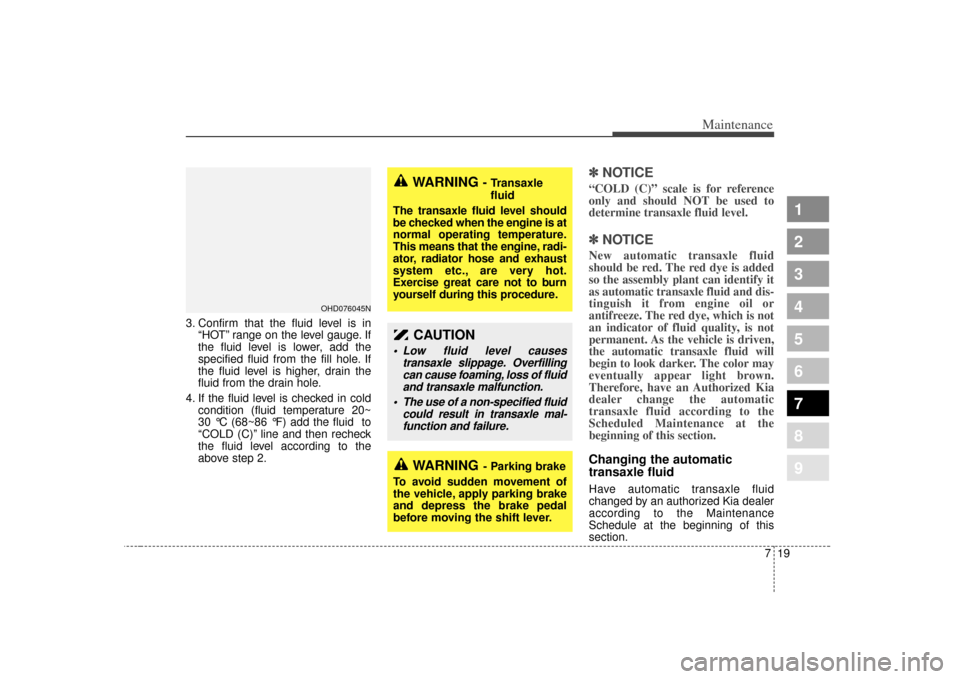
719
Maintenance
1
2
3
4
5
6
7
8
9
3. Confirm that the fluid level is in“HOT” range on the level gauge. If
the fluid level is lower, add the
specified fluid from the fill hole. If
the fluid level is higher, drain the
fluid from the drain hole.
4. If the fluid level is checked in cold condition (fluid temperature 20~
30 °C (68~86 °F) add the fluid to
“COLD (C)” line and then recheck
the fluid level according to the
above step 2.
✽ ✽NOTICE“COLD (C)” scale is for reference
only and should NOT be used to
determine transaxle fluid level.✽ ✽NOTICENew automatic transaxle fluid
should be red. The red dye is added
so the assembly plant can identify it
as automatic transaxle fluid and dis-
tinguish it from engine oil or
antifreeze. The red dye, which is not
an indicator of fluid quality, is not
permanent. As the vehicle is driven,
the automatic transaxle fluid will
begin to look darker. The color may
eventually appear light brown.
Therefore, have an Authorized Kia
dealer change the automatic
transaxle fluid according to the
Scheduled Maintenance at the
beginning of this section.Changing the automatic
transaxle fluidHave automatic transaxle fluid
changed by an authorized Kia dealer
according to the Maintenance
Schedule at the beginning of this
section.
CAUTION
Low fluid level causes
transaxle slippage. Overfillingcan cause foaming, loss of fluidand transaxle malfunction.
The use of a non-specified fluid could result in transaxle mal-function and failure.
WARNING
- Parking brake
To avoid sudden movement of
the vehicle, apply parking brake
and depress the brake pedal
before moving the shift lever.
OHD076045N
WARNING
- Transaxle
fluid
The transaxle fluid level should
be checked when the engine is at
normal operating temperature.
This means that the engine, radi-
ator, radiator hose and exhaust
system etc., are very hot.
Exercise great care not to burn
yourself during this procedure.
Page 277 of 300
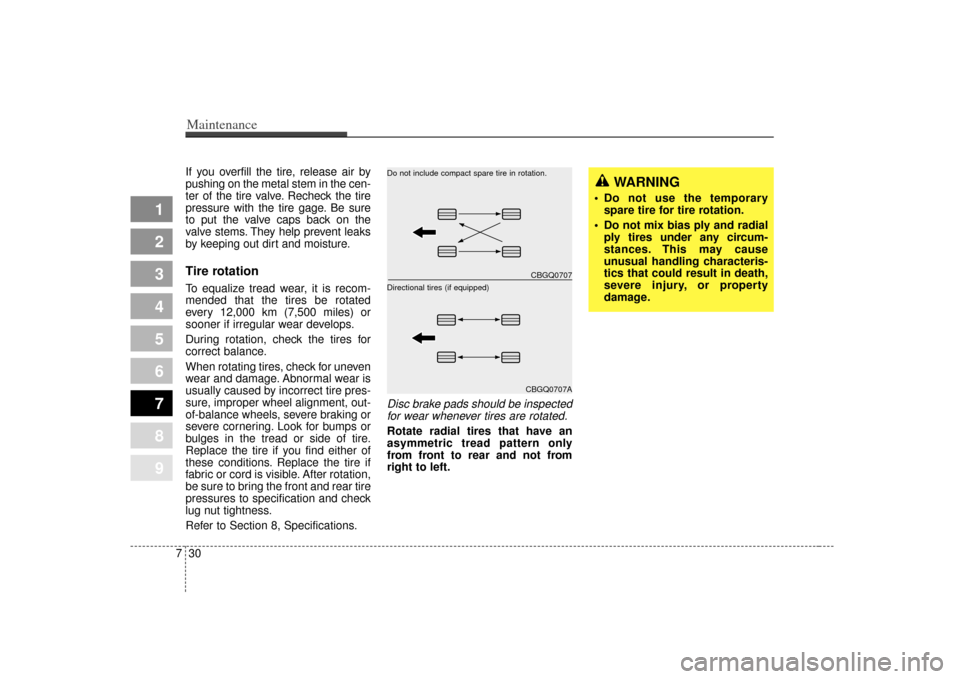
Maintenance30
7
1
2
3
4
5
6
7
8
9
If you overfill the tire, release air by
pushing on the metal stem in the cen-
ter of the tire valve. Recheck the tire
pressure with the tire gage. Be sure
to put the valve caps back on the
valve stems. They help prevent leaks
by keeping out dirt and moisture.Tire rotation To equalize tread wear, it is recom-
mended that the tires be rotated
every 12,000 km (7,500 miles) or
sooner if irregular wear develops.
During rotation, check the tires for
correct balance.
When rotating tires, check for uneven
wear and damage. Abnormal wear is
usually caused by incorrect tire pres-
sure, improper wheel alignment, out-
of-balance wheels, severe braking or
severe cornering. Look for bumps or
bulges in the tread or side of tire.
Replace the tire if you find either of
these conditions. Replace the tire if
fabric or cord is visible. After rotation,
be sure to bring the front and rear tire
pressures to specification and check
lug nut tightness.
Refer to Section 8, Specifications.
Disc brake pads should be inspected
for wear whenever tires are rotated.Rotate radial tires that have an
asymmetric tread pattern only
from front to rear and not from
right to left.
CBGQ0707CBGQ0707A
Do not include compact spare tire in rotation.
Directional tires (if equipped)
WARNING
Do not use the temporary spare tire for tire rotation.
Do not mix bias ply and radial ply tires under any circum-
stances. This may cause
unusual handling characteris-
tics that could result in death,
severe injury, or property
damage.
Page 289 of 300
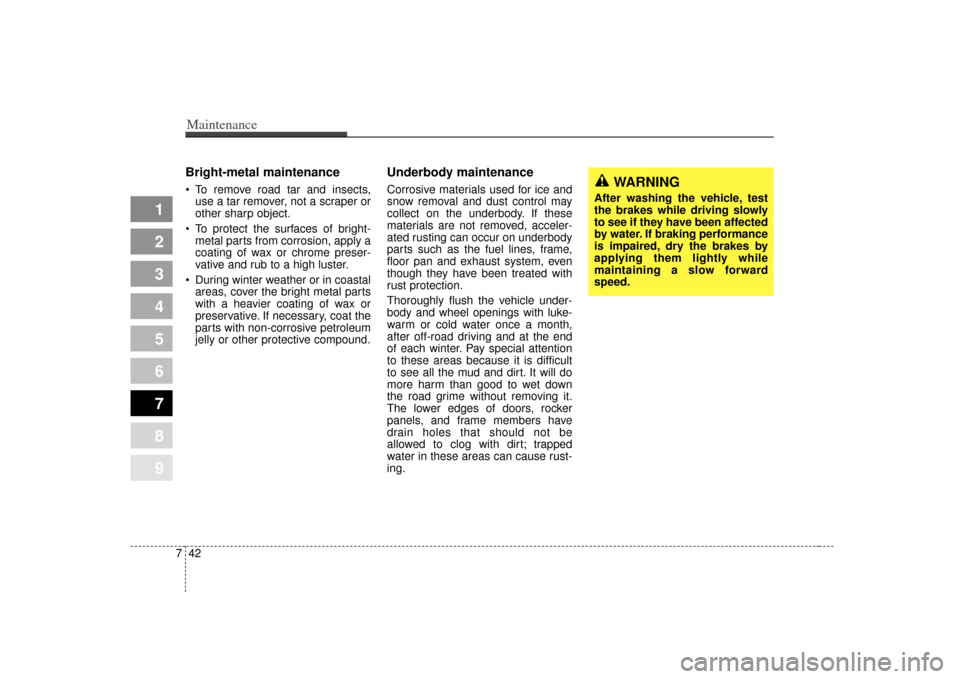
Maintenance42
7
1
2
3
4
5
6
7
8
9
Bright-metal maintenance To remove road tar and insects,
use a tar remover, not a scraper or
other sharp object.
To protect the surfaces of bright- metal parts from corrosion, apply a
coating of wax or chrome preser-
vative and rub to a high luster.
During winter weather or in coastal areas, cover the bright metal parts
with a heavier coating of wax or
preservative. If necessary, coat the
parts with non-corrosive petroleum
jelly or other protective compound.
Underbody maintenanceCorrosive materials used for ice and
snow removal and dust control may
collect on the underbody. If these
materials are not removed, acceler-
ated rusting can occur on underbody
parts such as the fuel lines, frame,
floor pan and exhaust system, even
though they have been treated with
rust protection.
Thoroughly flush the vehicle under-
body and wheel openings with luke-
warm or cold water once a month,
after off-road driving and at the end
of each winter. Pay special attention
to these areas because it is difficult
to see all the mud and dirt. It will do
more harm than good to wet down
the road grime without removing it.
The lower edges of doors, rocker
panels, and frame members have
drain holes that should not be
allowed to clog with dirt; trapped
water in these areas can cause rust-
ing.
WARNING
After washing the vehicle, test
the brakes while driving slowly
to see if they have been affected
by water. If braking performance
is impaired, dry the brakes by
applying them lightly while
maintaining a slow forward
speed.
Page 295 of 300
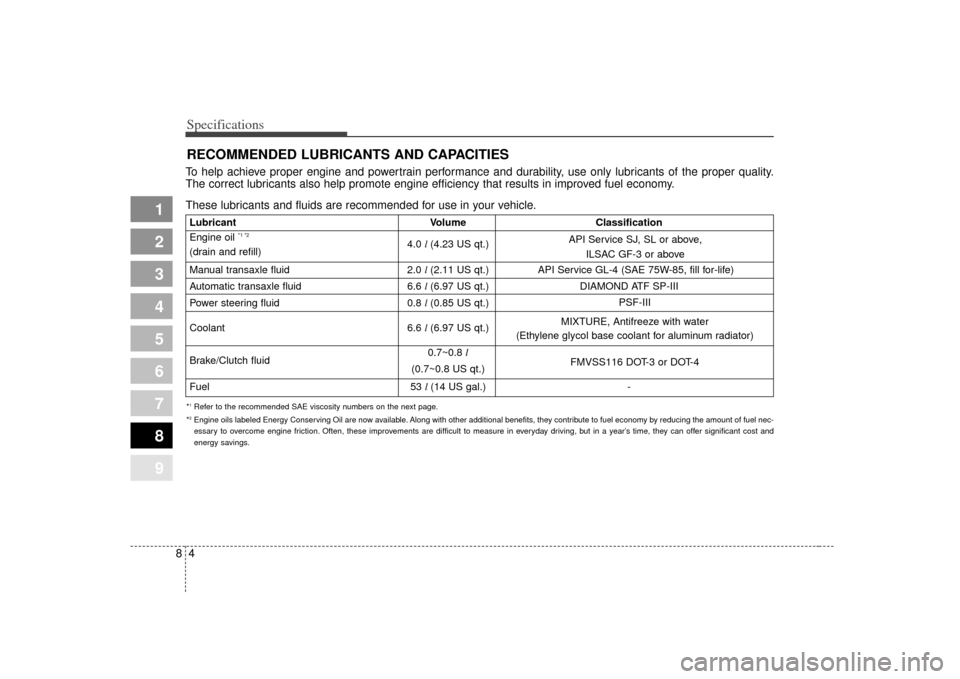
Specifications48
1
2
3
4
5
6
7
8
9
RECOMMENDED LUBRICANTS AND CAPACITIES To help achieve proper engine and powertrain performance and durability, use only lubricants of the proper quality.
The correct lubricants also help promote engine efficiency that results in improved fuel economy.These lubricants and fluids are recommended for use in your vehicle.*1Refer to the recommended SAE viscosity numbers on the next page.
*2Engine oils labeled Energy Conserving Oil are now available. Along with other additional benefits, they contribute to fuel economy by reducing the amount of fuel nec-
essary to overcome engine friction. Often, these improvements are difficult to measure in everyday driving, but in a year’s time, they can offer significant cost and
energy savings.Lubricant Volume Classification
Engine oil
*1 *2
4.0 l (4.23 US qt.)
(drain and refill)
Manual transaxle fluid 2.0 l (2.11 US qt.)
Automatic transaxle fluid 6.6 l (6.97 US qt.)DIAMOND ATF SP-III
Power steering fluid 0.8 l (0.85 US qt.)
Coolant 6.6 l (6.97 US qt.)
Brake/Clutch fluid 0.7~0.8
l
(0.7~0.8 US qt.)
Fuel 53 l (14 US gal.) -
API Service SJ, SL or above,
ILSAC GF-3 or above
API Service GL-4 (SAE 75W-85, fill for-life)
PSF-III
FMVSS116 DOT-3 or DOT-4
MIXTURE, Antifreeze with water
(Ethylene glycol base coolant for aluminum radiator)
Page 298 of 300
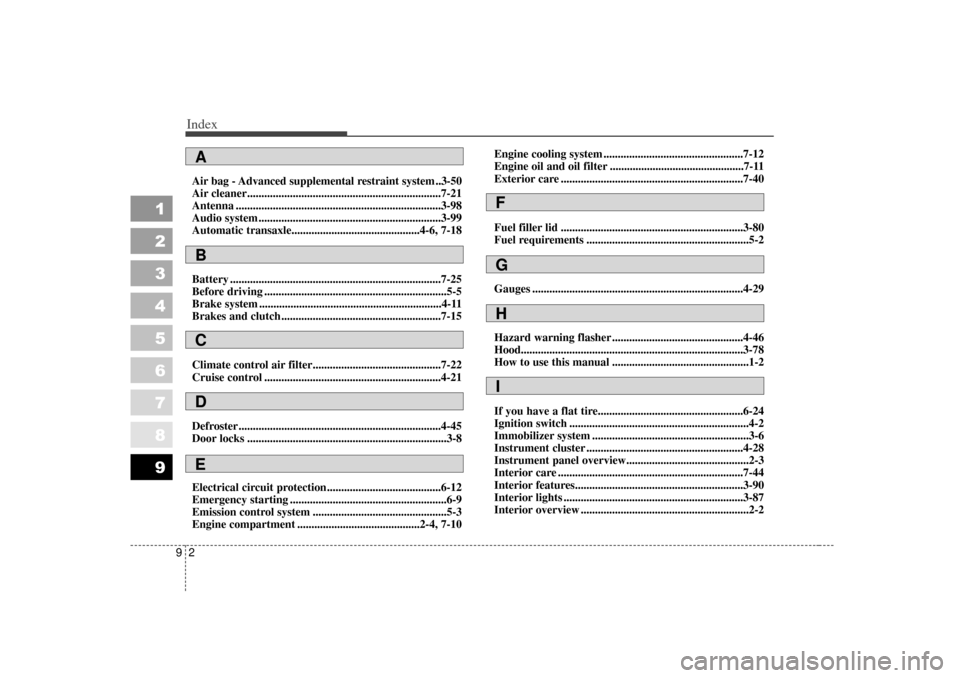
Index29
1
2
3
4
5
6
7
8
9
Air bag - Advanced supplemental restraint system ..3-50
Air cleaner....................................................................7-21\
Antenna ........................................................................\
3-98
Audio system ................................................................3-99
Automatic transaxle.............................................4-6, 7-18
Battery ........................................................................\
..7-25
Before driving ................................................................5-5
Brake system ................................................................4-11
Brakes and clutch ........................................................7-15
Climate control air filter.............................................7-22
Cruise control ..............................................................4-21
Defroster .......................................................................4\
-45
Door locks ......................................................................3-\
8
Electrical circuit protection........................................6-12
Emergency starting .......................................................6-9
Emission control system ...............................................5-3
Engine compartment ...........................................2-4, 7-10Engine cooling system .................................................7-12
Engine oil and oil filter ...............................................7-11
Exterior care ................................................................7-40
Fuel filler lid ................................................................3-80
Fuel requirements .........................................................5-2
Gauges ........................................................................\
..4-29
Hazard warning flasher ..............................................4-46
Hood....................................................................\
..........3-78
How to use this manual ................................................1-2
If you have a flat tire...................................................6-24
Ignition switch ...............................................................4-2
Immobilizer system .......................................................3-6
Instrument cluster .......................................................4-28
Instrument panel overview...........................................2-3
Interior care .................................................................7-44
Interior features...........................................................3-90
Interior lights ...............................................................3-87
Interior overview ...........................................................2-2ABCDE
GFHI
Page 299 of 300
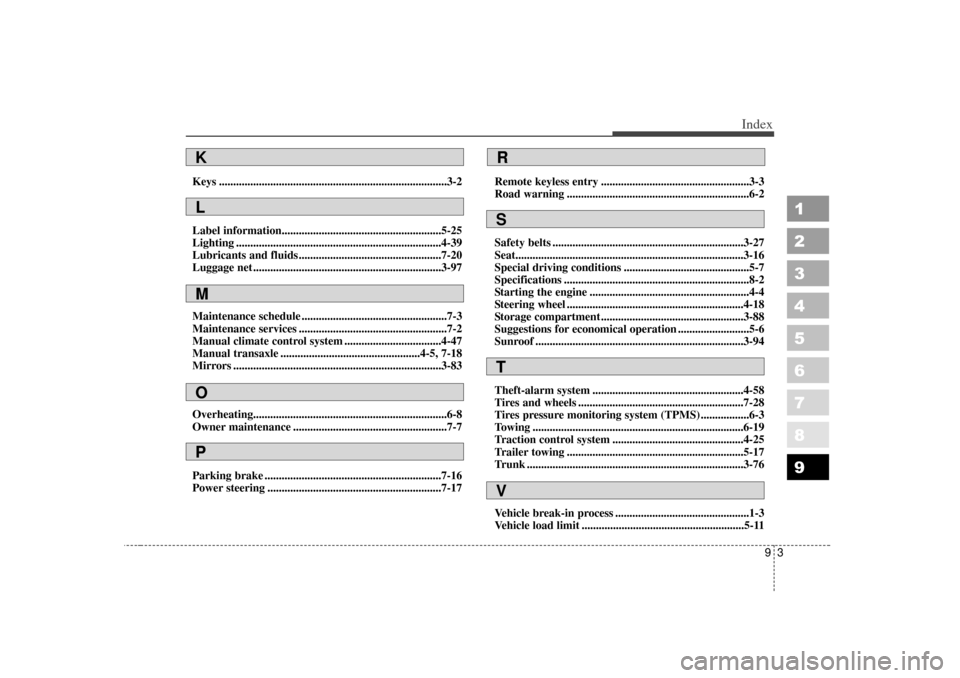
93
1
2
3
4
5
6
7
8
9
Index
Keys ........................................................................\
........3-2
Label information........................................................5-25
Lighting ........................................................................\
4-39
Lubricants and fluids ..................................................7-20
Luggage net ..................................................................3-97
Maintenance schedule ...................................................7-3
Maintenance services ....................................................7-2
Manual climate control system ..................................4-47
Manual transaxle .................................................4-5, 7-18
Mirrors ........................................................................\
.3-83
Overheating.............................................................\
.......6-8
Owner maintenance ......................................................7-7
Parking brake ..............................................................7-16
Power steering .............................................................7-17Remote keyless entry ....................................................3-3
Road warning ................................................................6-2
Safety belts ...................................................................3-27
Seat....................................................................\
............3-16
Special driving conditions ............................................5-7
Specifications .................................................................8-2
Starting the engine ........................................................4-4
Steering wheel ..............................................................4-18
Storage compartment ..................................................3-88
Suggestions for economical operation .........................5-6
Sunroof ........................................................................\
.3-94
Theft-alarm system .....................................................4-58
Tires and wheels ..........................................................7-28
Tires pressure monitoring system (TPMS) .................6-3
Towing ........................................................................\
..6-19
Traction control system ..............................................4-25
Trailer towing ..............................................................5-17
Trunk ........................................................................\
....3-76
Vehicle break-in process ...............................................1-3
Vehicle load limit .........................................................5-11KLMOP
RSTV